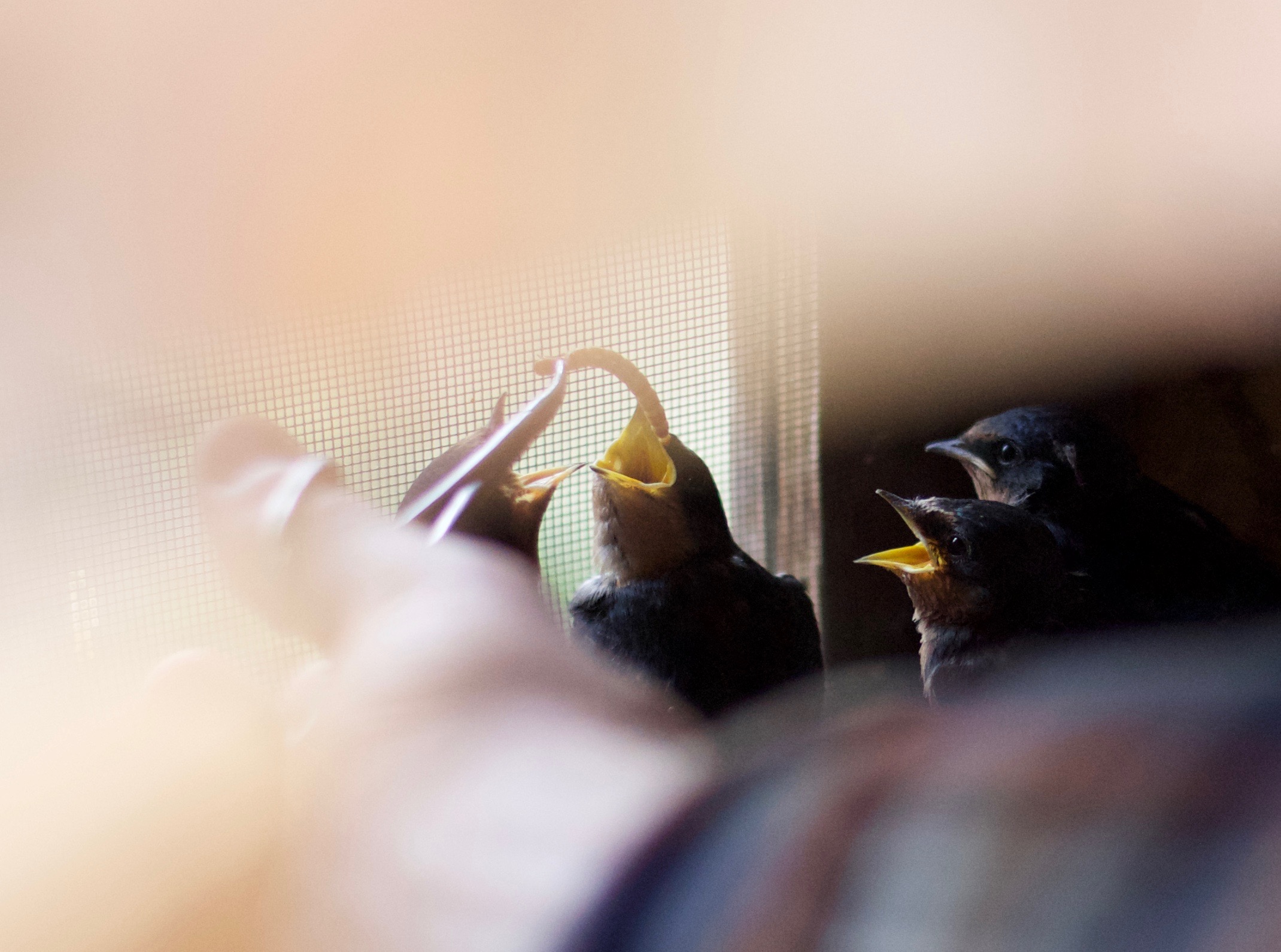
A volunteer feeds young Cliff Swallows (Petrochelidon pyrrhonota) on the verge of taking their first flight from our fledging box into the bright songbird aviary just beyond the screen. (photo: Laura Corsiglia /BAX)
Right now, our wildlife clinic, Humboldt Wildlife Care Center, has nearly 100 patients in care. Ranging from a dozen Cliff Swallows, each from a nest somehow destroyed, to an Osprey whose feathers were badly singed by a nest fire near Weaverville; – from 23 orphaned young Raccoons to the 3 chipmunks found in a garage after their mother was killed by a trap.
We need your help! Want to help buy the formula, the fish, the supplies, the water, the electricity and more that we need? Click here to make a contribution through paypal, or send a check! Thank you!!!
Every day our phone rings dozens of times with calls from our neighbors near and far who’ve had an encounter, a conflict, or a question about a wild animal they just saw. Most people who call want to find help for an animal in need. Not every one who calls is a friend of the wild.
We give each caller the best we have, to advocate for the wild. The situation could be anything. It may be an animal in a trap, desperate for release and it is our task to make sure this is done, or it may be that there’s a nest with just hatched babies that someone wants to remove, or someone 80 miles away may have found an orphan who needs stabilizing care as soon as possible, and we are the closest facility.
Each call is that animal’s last shot at another chance. And sometimes we fail.
Sometimes the person calling doesn’t want to let the opossum out of the trap and the line goes dead. We call back and there is no answer. And we have nearly one hundred patients in care. Maybe we can’t save this opossum, but we do have other mouths to feed. So we move forward, carrying the phone in our pocket.
Summer is a remarkable season for a wildlife rehabilitation clinic. For many others, it’s a time of relaxation and outdoor enjoyment. For us, our hours are long; the tasks are hard. Still, the joys of seeing our patients mature into capable juveniles and adults are immeasurable. And the slow, silent changes the work makes in us – day in, day out – minute by minute – year by year – are endlessly surprising. We might expect to rise in the morning and find leaves growing from our hair, or certain desires to back into our musky dens and rest our chins on our forepaws through the night.
We do a pretty good job raising fierce little wild raccoons who we are certain are ready to be free in the wild universe at their release. We have good raccoon feeding protocols, and we watch them closely for success. We keep the intelligent and inqusitive young explorers as apart from us as we can, so that they might always prefer a field we don’t dominate. We give them the best schooling we can on where the food is, and why climbing is important. We keep them safe until keeping them causes them harm. It takes about 4 months, usually. Over 80% of the orphaned raccoon we treat make it. When they don’t survive, they are usually very young.
Last week, we lost a little guy, a male raccoon, small enough to hold in your hand. He went suddenly. In the course of a few hours on a weekend afternoon, he went from seemingly healthy to dead. His eyes had been open about ten days. Once his death was confirmed, we opened him to learn why. There were no clues. Just small raccoon ribs making a beautiful tiny cavern for his pink lungs and there, right against his spine, his wee raccoon heart. From his ancestral past to his guard hairs and whiskers to his utter core he was a beautiful raccoon, all wild, all fierce…
Our clinic is a small one. There are bigger facilities in other parts of the state, all over the world. We treat about 1200 patients each year and we help resolve the conflicts that may be saving a few thousand more from becoming injured that time, that day.
We operate on a quarter-acre of land alongside Jacoby Creek on the edge of Humboldt Bay. Our ‘campus’ consists of a double-wide mobile unit with thoughtful and frugal recovery enclosures for a variety of species, built in manner of homestead outbuildings on our very meager budget. Yet we are one of the points of congress between the built world and the wild.
Our clinic is a portal between the human and the wild that operates every day of the year. Our daily proximity to the wild, in the form of her orphaned and injured children, exposes caregivers, makes us more wild. Here at the center of the Redwood Coast, on the edge of our great Western Sea, under the sky and standing on ground that has seen thousands of years joy and sorrow, beauty and tragedy – suffered the losses of forests, of people, of species, of stability, here we are, now, alive, breathing, dreaming, and striving to help those for whom there would be nothing if we weren’t here.
We are one of the small hearts you’ll find at the center of everything.
PLEASE HELP. Your contribution goes directly toward our mission.


